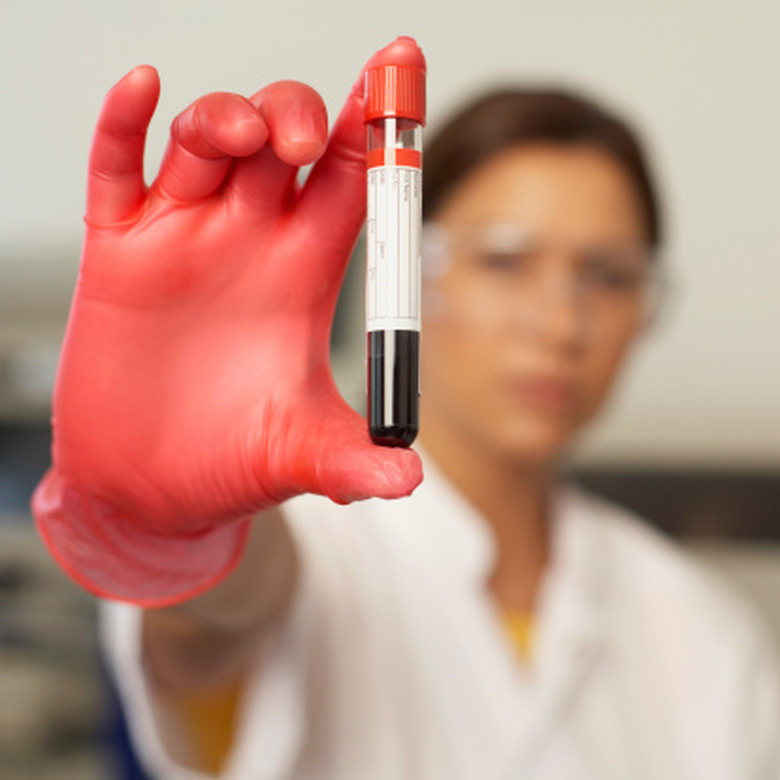Difference Between Granular & Agranular Leukocytes
Blood has three important functions in the human body. The first is to transport various gases, nutrients and compounds throughout the body to supply cells and tissues with everything they need to function. For example, blood transports oxygen, carbon dioxide, glucose, nutrients and even waste products to their proper locations throughout the body.
The second important function of blood is regulation of homeostasis. Blood helps regulate and transport hormones as well as regulate our body temperature. The third and perhaps most well-known function of blood involved protecting the body from harm and disease. Red blood cells are mainly involved in the transport of oxygen throughout the body.
White blood cells, known as leukocytes, are a key part of our immune system. Leukocytes can be divided into two distinct types: granular and agranular leukocytes.
What Are Leukocytes?
What Are Leukocytes?
Leukocytes are also called **white blood cells**. These cells have a nucleus, unlike red blood cells that lack a nucleus. Also unlike red blood cells, white blood cells do not contain hemoglobin, which means they're not involved in the transport of oxygen.
The various types of white blood cells are all involved in protecting the body from wounds, disease, foreign bodies, pathogens, inflammation and other immune responses.
Granular vs Agranular Leukocytes
Granular vs Agranular Leukocytes
Granular leukocytes, also called granular or granulated white blood cells, contain granules in their cytoplasm. Granules are tiny sacs that contain various enzymes, compounds and other components that are used to defend against pathogens, reduce inflammation and destroy cells. What the granules are filled with or used for depends on the specific type of granular leukocyte.
Agranular leukocytes, also called agranular or agranulated white blood cells, usually lack these granules. While they may still contain a few, they're in a much fewer number and aren't relied on for their function as they are in granular leukocytes.
Granular Leukocytes
Granular Leukocytes
There are three types of granular leukocytes:
1. Neutrophils 2. Eosinophils 3. Basophils
Neutrophils are the most common type of leukocyte, granular or agranular. They make up 50 to 70 percent of human leukocyte counts. They get their name "neutrophil" thanks to the neutral pH of the components that make up their granules.
The main function of neutrophils is as phagocytes (cells that engulf and destroy foreign bodies, usually bacteria and viruses). The granules themselves contain lysozymes (enzymes that breaks down cell walls), various oxidants used for destroying cells and molecules called defensins that bind and destroy bacterial/fungal cell walls/membranes. Increased neutrophil counts usually indicate a bacterial infection. Low counts are correlated to increased risk of infection.
Eosinophils are mainly responsible for helping to break down blood clots and releasing chemicals that can kill parasites, especially parasitic worms. Their granules can also contain histamines, which are released in response to a pathogen entering the system. These make up about 2 to 4 percent of your total leukocyte count.
Basophils are the rarest type of leukocytes, making up less than 1 percent of your total leukocyte count. Their function is still unclear, but most scientists agree that they also release histamines and anti-clotting chemicals in response to wounds and potential infections/pathogens/antigens.
Agranular Leukocytes
Agranular Leukocytes
There are two main types of agranular leukocytes: monocytes and lymphocytes.
Monocytes make up anywhere between 2 and 8 percent of all leukocytes in the blood. They're usually quite large, which helps with their primary function: phagocytosis of everything from pathogens to old blood cells to cellular debris to dead cells. They can also secrete chemicals that will bring other types of leukocytes to an area that needs help such as an area of infection or a wound.
Lymphocytes form in the bone marrow and replicate in the lymphatic system like the lymph nodes. They're the second most common leukocyte at 20 to 30 percent of total leukocytes. These are the immune cells that are responsible for the production of antibodies and inducing an immune response against pathogens and antigens that enter the body.
Cite This Article
MLA
Walsh, Elliot. "Difference Between Granular & Agranular Leukocytes" sciencing.com, https://www.sciencing.com/difference-between-granular-agranular-leukocytes-8455725/. 9 July 2019.
APA
Walsh, Elliot. (2019, July 9). Difference Between Granular & Agranular Leukocytes. sciencing.com. Retrieved from https://www.sciencing.com/difference-between-granular-agranular-leukocytes-8455725/
Chicago
Walsh, Elliot. Difference Between Granular & Agranular Leukocytes last modified March 24, 2022. https://www.sciencing.com/difference-between-granular-agranular-leukocytes-8455725/
